General, Sir John Monash, Personal Files Book 22, 2 January - 1 February 1919- Part 7
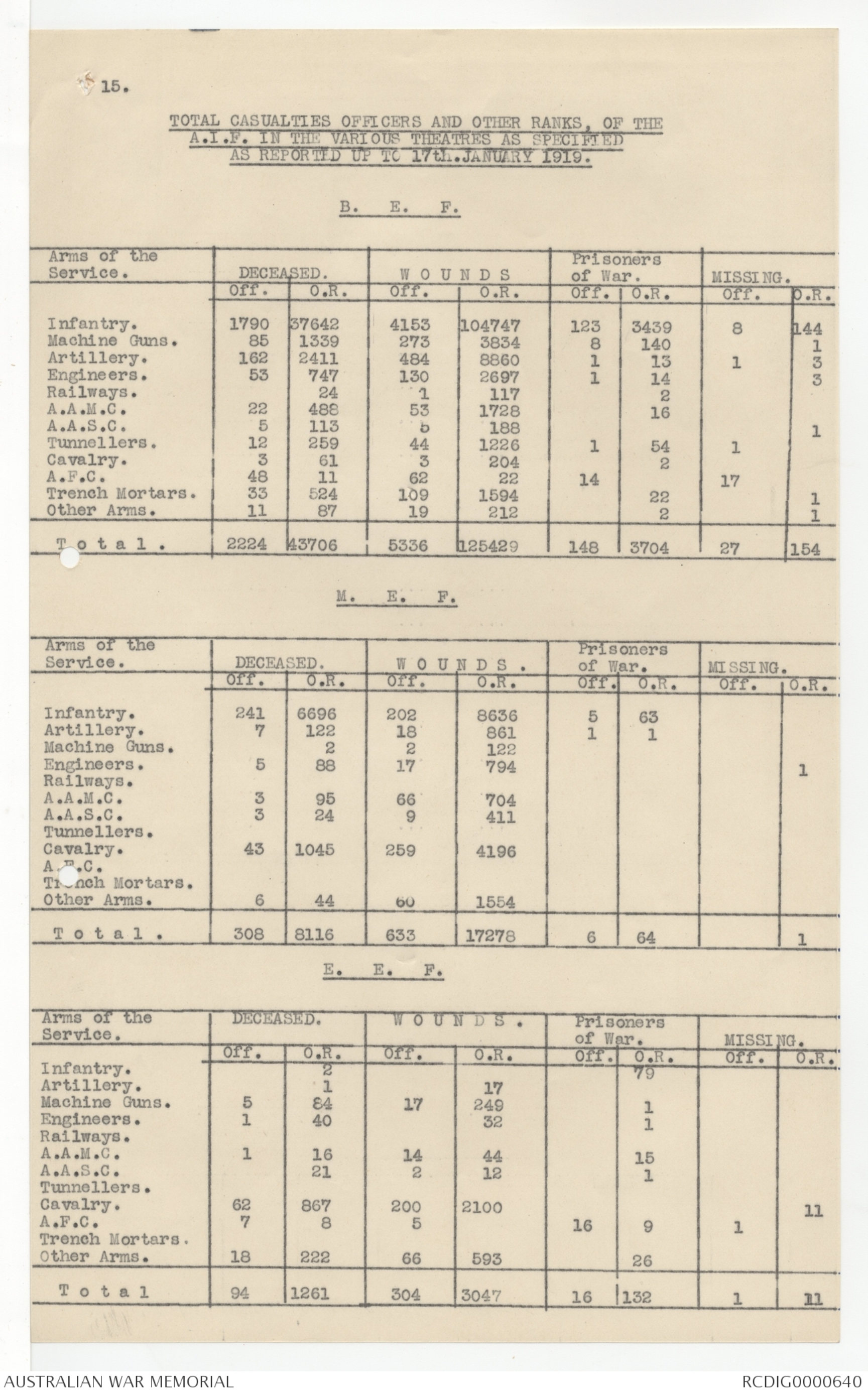
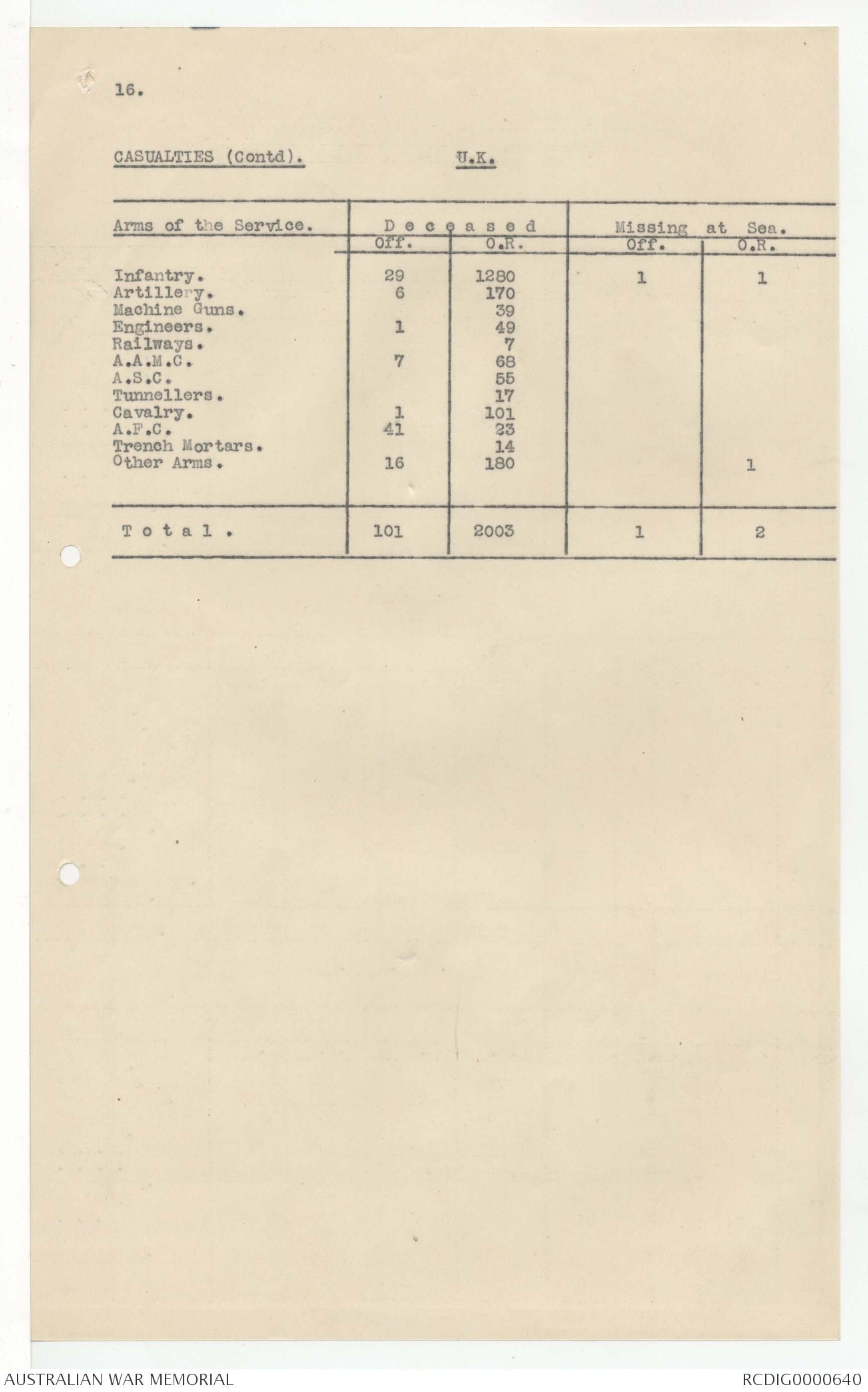
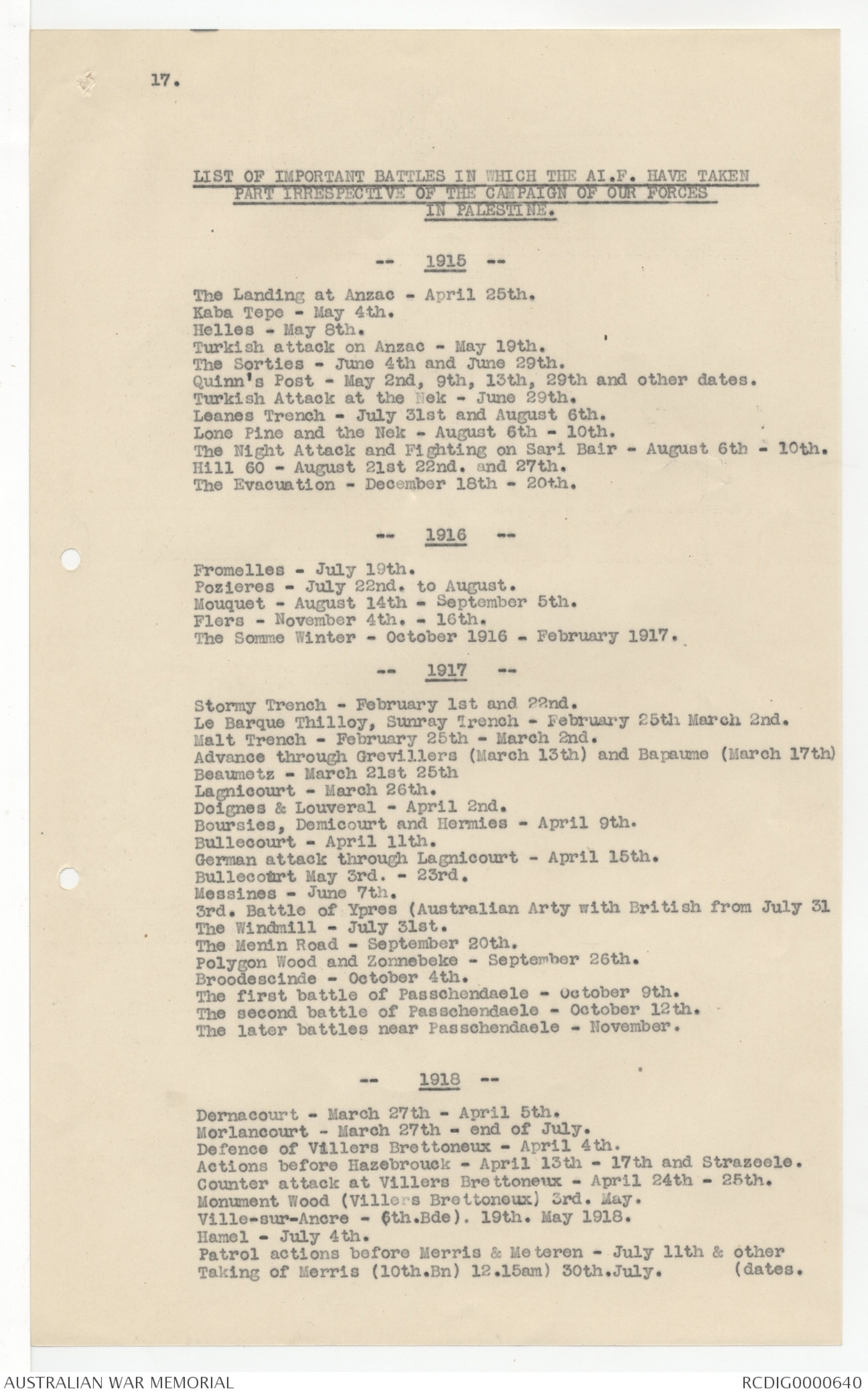
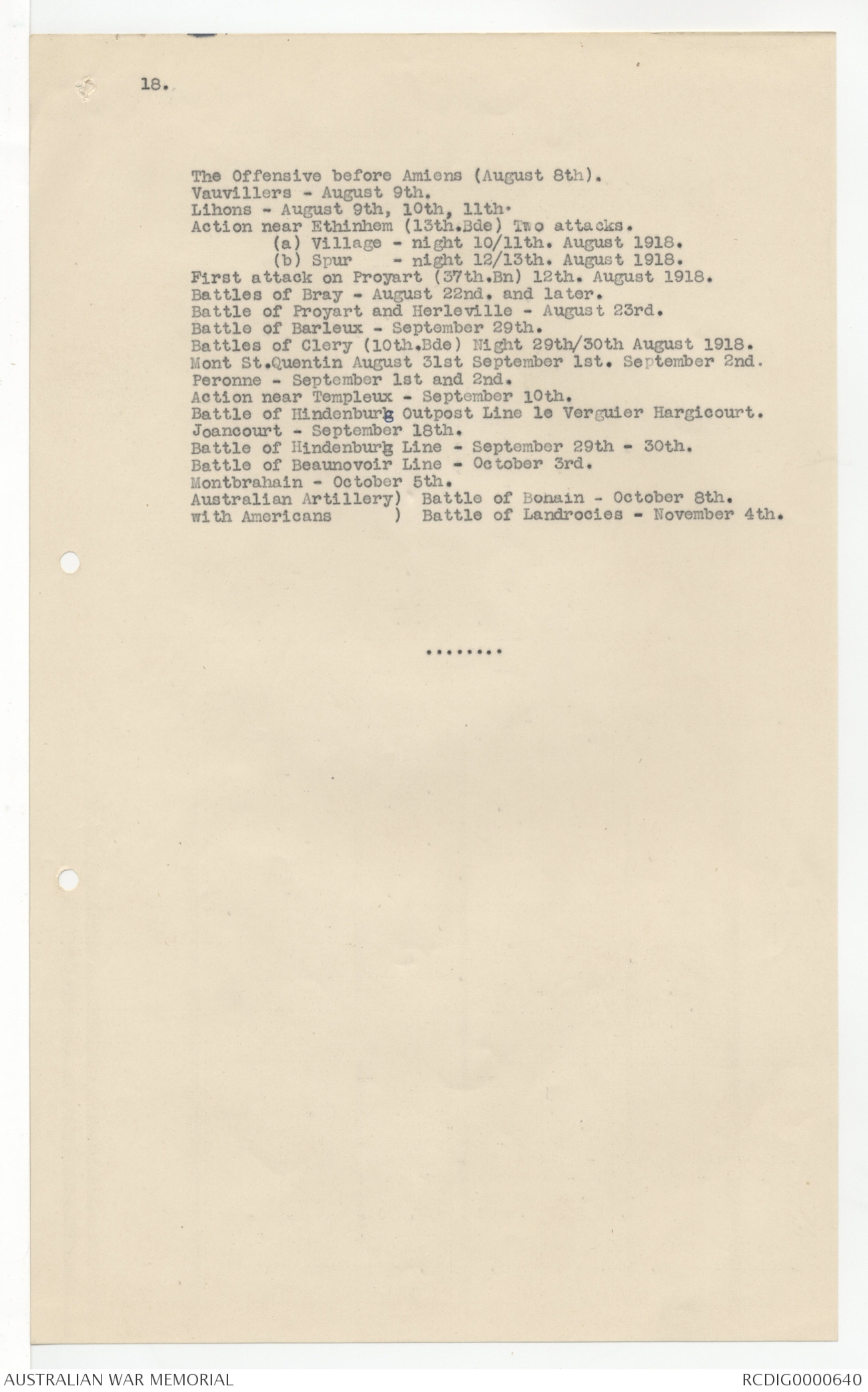
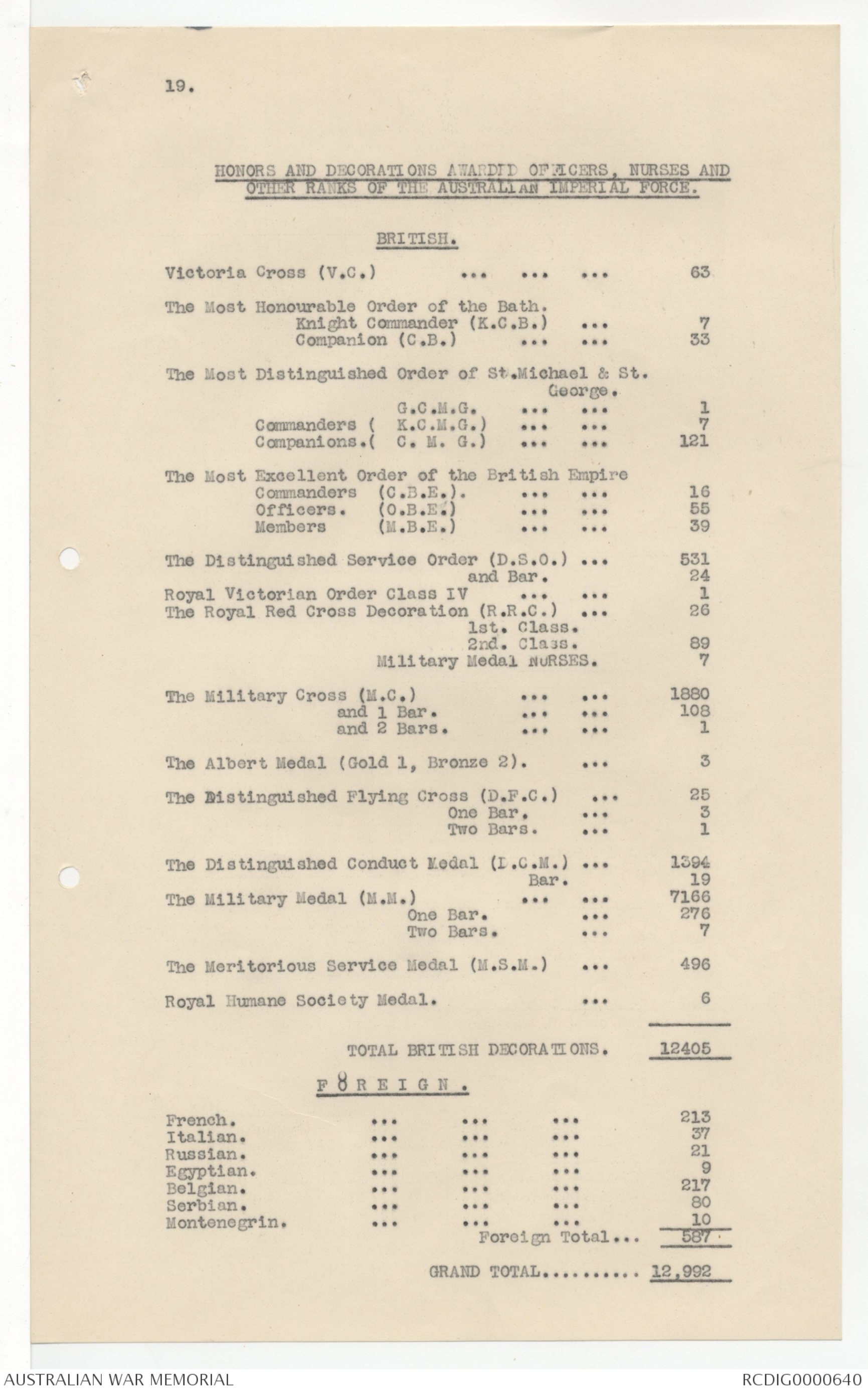
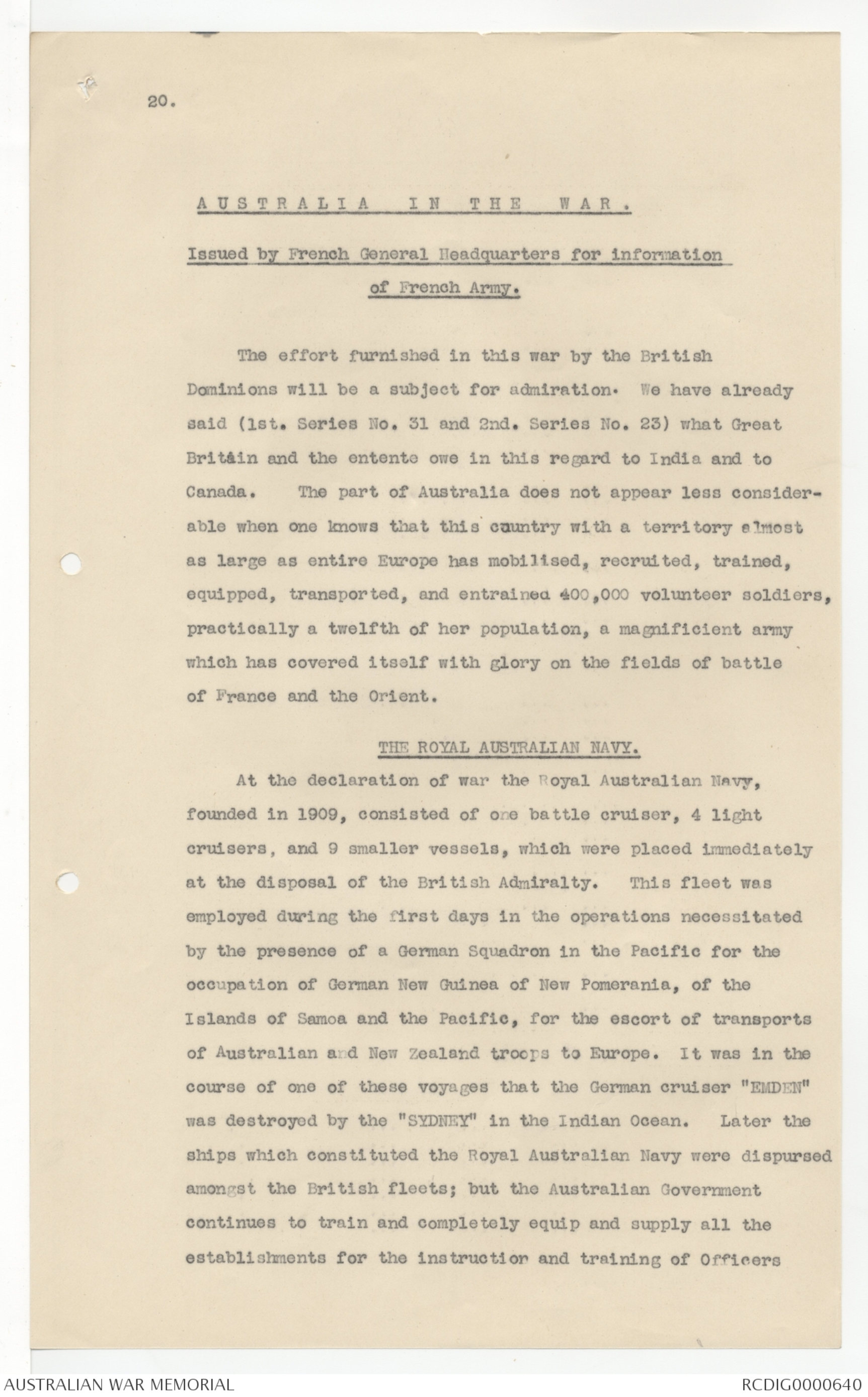
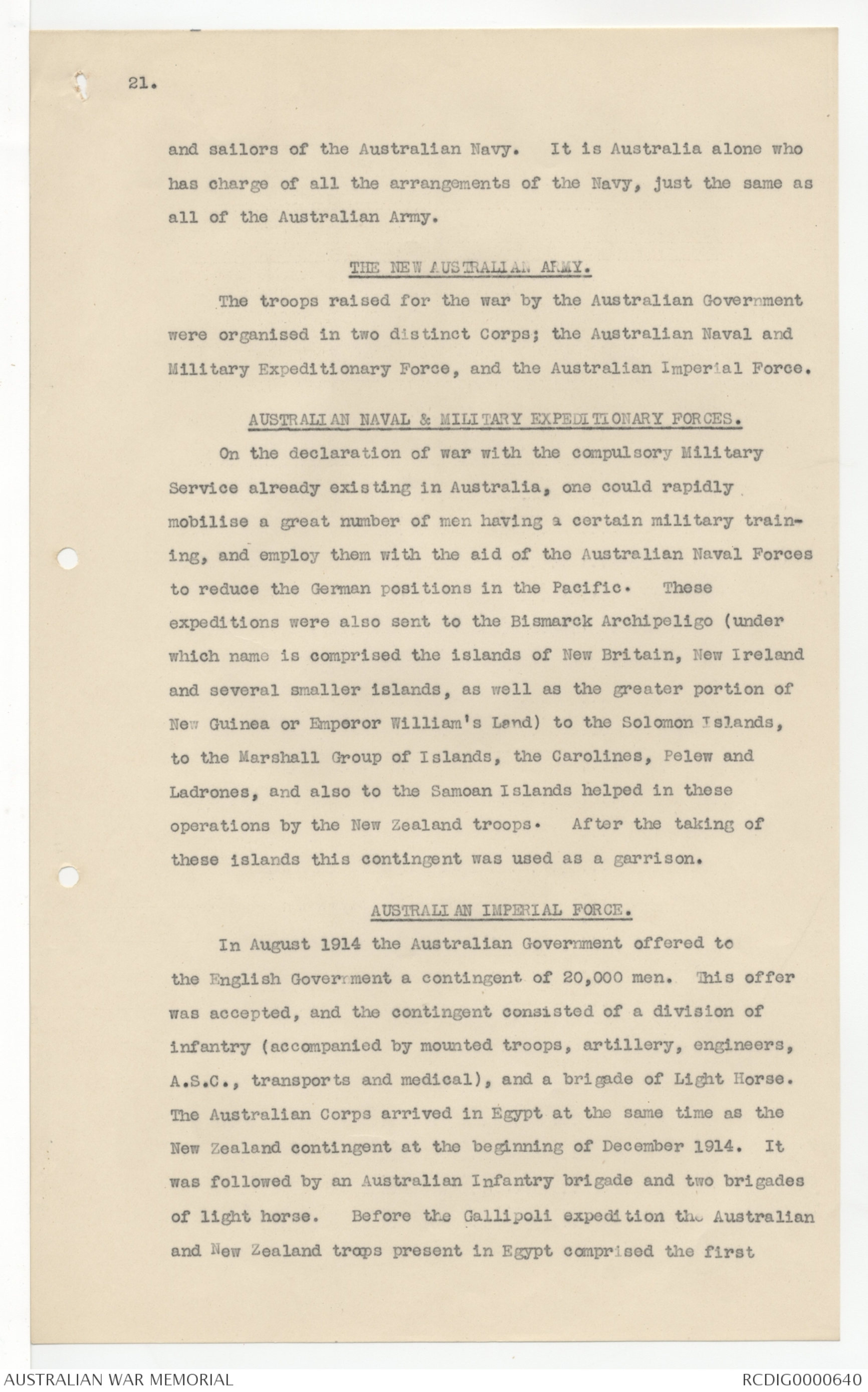
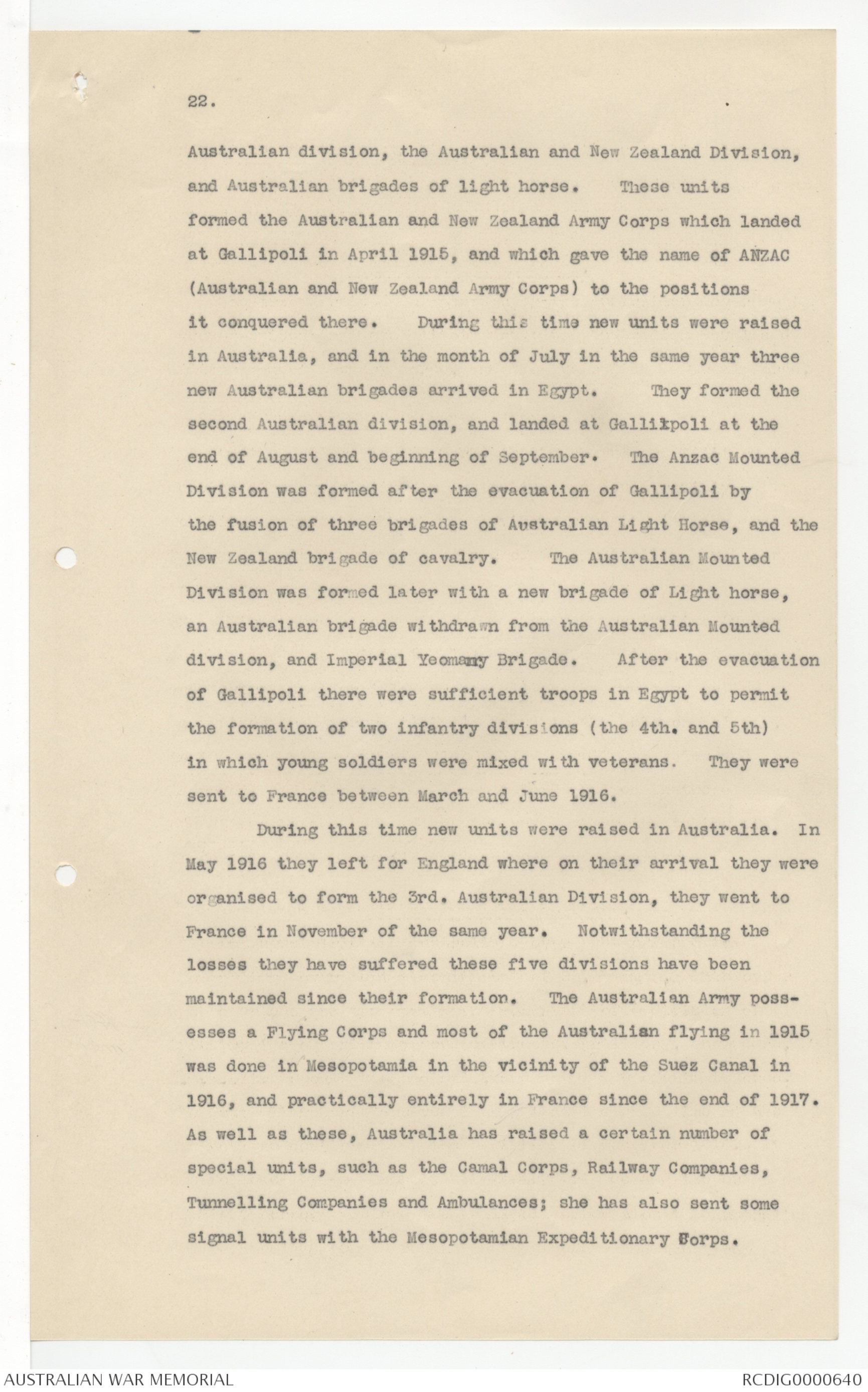
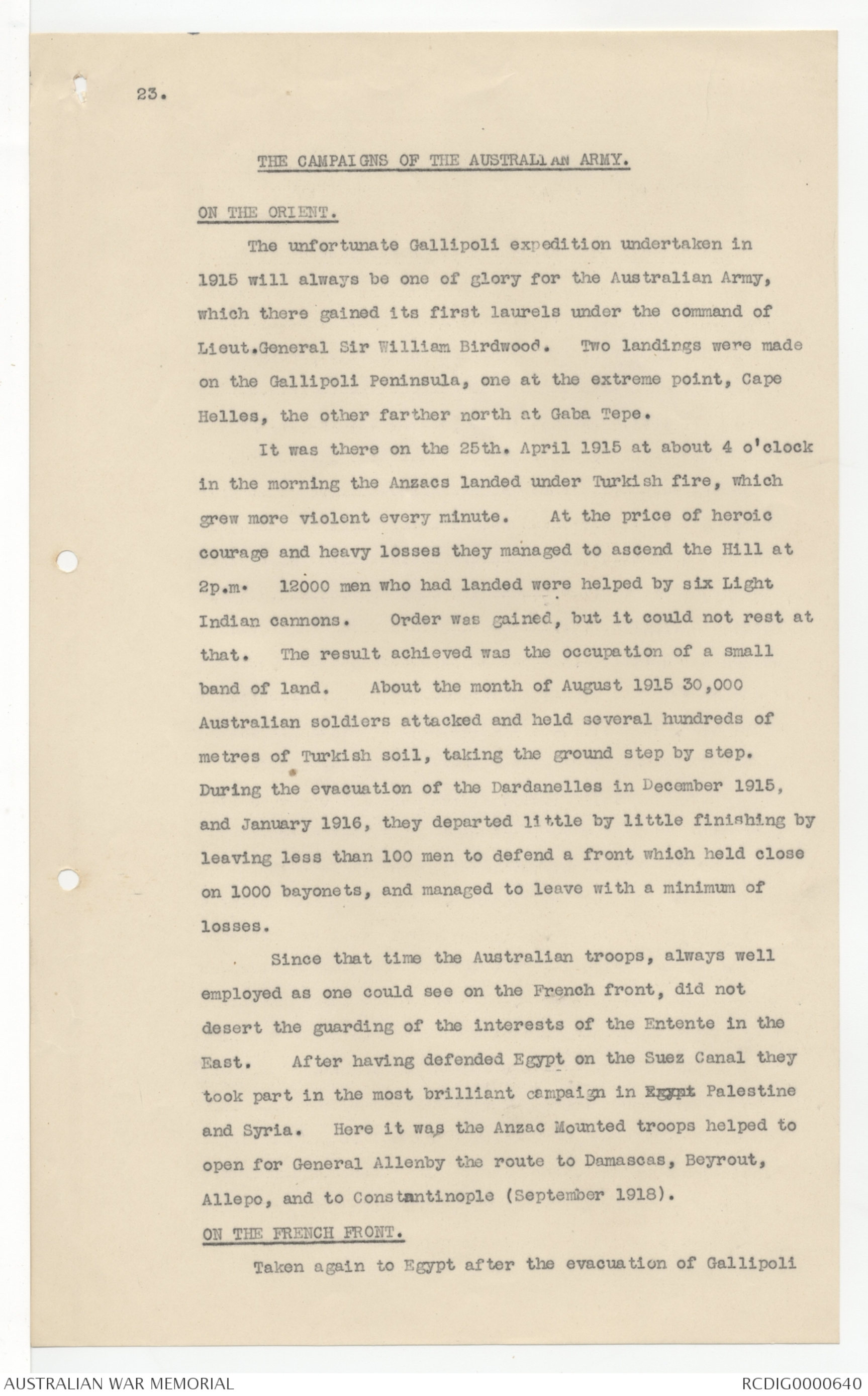
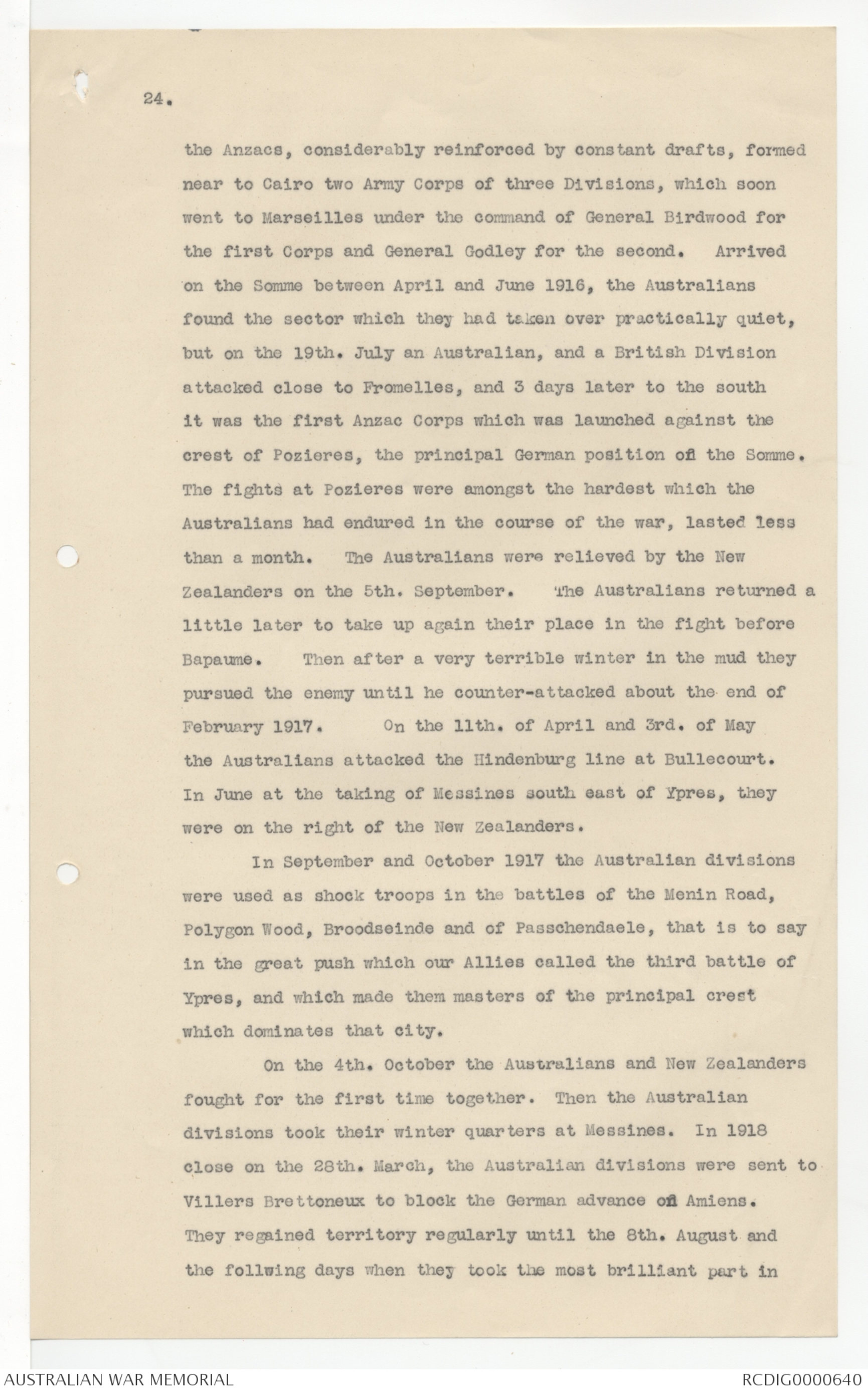
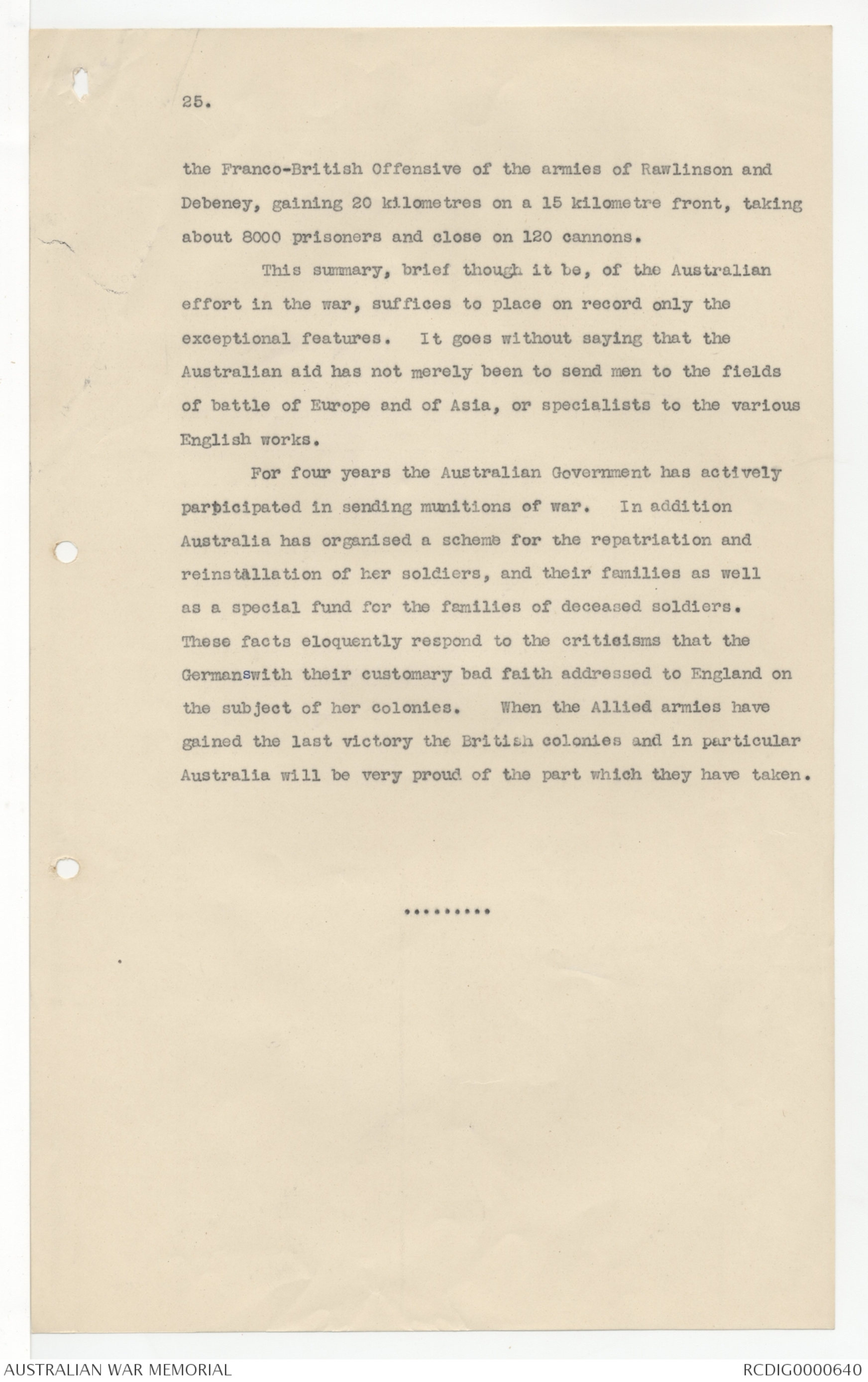
15.
TOTAL CASUALTIES OFFICERS AND OTHER RANKS, OF THE
A.I.F. DURING THE VARIOUS THEATRES AS SECIFIED
AS REPORTED UP TO 17th. January 1919.
| B.E.F. | ||||||||
| Arms of the Service. |
DECEASED | WOUNDS | Prisoners Of War. |
MISSING. | ||||
| Off. | O.R. | Off. | O.R. | Off. | O.R. | Off. | O.R. | |
| Infantry. | 1790 | 37642 | 4153 | 104747 | 123 | 3439 | 8 | 144 |
| Machine Guns. | 85 | 1339 | 273 | 3834 | 8 | 140 | 1 | |
| Artillery. | 152 | 2411 | 484 | 8860 | 1 | 13 | 1 | 3 |
| Engineers. | 53 | 747 | 130 | 2697 | 1 | 14 | 3 | |
| Railways. | 24 | 1 | 117 | 2 | ||||
| A.A.M.C. | 22 | 488 | 53 | 1728 | 16 | |||
| A.A.S.C. | 5 | 113 | 5 | 188 | 1 | |||
| Tunnellers. | 12 | 259 | 44 | 1226 | 1 | 54 | 1 | |
| Cavalry. | 3 | 61 | 3 | 204 | 2 | |||
| A.F.C. | 48 | 11 | 62 | 22 | 14 | 17 | ||
| Trench Mortars. | 33 | 524 | 109 | 1594 | 22 | 1 | ||
| Other Arms. | 11 | 87 | 19 | 212 | 2 | 1 | ||
| Total. | 2224 | 43706 | 5336 | 125429 | 148 | 3704 | 27 | 154 |
| M.E.F. | ||||||||
| Arms of the Service. |
DECEASED | WOUNDS | Prisoners Of War. |
MISSING. | ||||
| Off. | O.R. | Off. | O.R. | Off. | O.R. | Off. | O.R. | |
| Infantry. | 241 | 6696 | 202 | 8636 | 5 | 63 | ||
| Machine Guns. | 7 | 122 | 18 | 861 | 1 | 1 | ||
| Artillery. | 2 | 2 | 122 | |||||
| Engineers. | 5 | 88 | 17 | 794 | 1 | |||
| Railways. | ||||||||
| A.A.M.C. | 3 | 95 | 66 | 704 | ||||
| A.A.S.C. | 3 | 24 | 9 | 411 | ||||
| Tunnellers. | ||||||||
| Cavalry. | 43 | 1045 | 259 | 4196 | ||||
| A.F.C. | ||||||||
| Trench Mortars. | ||||||||
| Other Arms. | 6 | 44 | 60 | 1554 | ||||
| Total. | 308 | 8116 | 633 | 17278 | 6 | 64 | 1 | |
| E.E.F. | ||||||||
| Arms of the Service. |
DECEASED | WOUNDS | Prisoners Of War. |
MISSING. | ||||
| Off. | O.R. | Off. | O.R. | Off. | O.R. | Off. | O.R. | |
| Infantry. | 2 | 79 | ||||||
| Machine Guns. | 5 | 1 | 17 | |||||
| Artillery. | 1 | 84 | 17 | 249 | 1 | |||
| Engineers. | 40 | 32 | 1 | |||||
| Railways. | ||||||||
| A.A.M.C. | 1 | 16 | 14 | 44 | 15 | |||
| A.A.S.C. | 21 | 2 | 12 | 1 | ||||
| Tunnellers. | ||||||||
| Cavalry. | 62 | 867 | 200 | 2100 | 11 | |||
| A.F.C. | 7 | 8 | 5 | 16 | 9 | 1 | ||
| Trench Mortars. | ||||||||
| Other Arms. | 18 | 222 | 66 | 593 | 26 | |||
| Total. | 94 | 1261 | 304 | 3047 | 16 | 132 | 1 | 11 |
16.
CASUALTIEs (Contd). U.K.
| Arms of the Service. | Deceased | Missing at Sea. | ||
| Off. | O.R. | Off. | O.R. | |
| Infantry. | 29 | 1280 | 1 | 1 |
| Machine Guns. | 6 | 170 | ||
| Artillery. | 39 | |||
| Engineers. | 1 | 49 | ||
| Railways. | 7 | |||
| A.A.M.C. | 7 | 68 | ||
| A.A.S.C. | 55 | |||
| Tunnellers. | 17 | |||
| Cavalry. | 1 | 101 | ||
| A.F.C. | 41 | 23 | ||
| Trench Mortars. | 14 | |||
| Other Arms. | 16 | 180 | 1 | |
| Total. | 101 | 2003 | 1 | 2 |
17.
LIST OF IMPORTANT BATTLES IN WHICH THE A.I.F. HAVE TAKEN
PART IRRESPTCTIVE OF THE CAMPAIGN OF OUR FORCE
IN PALESTINE.
--1915--
The Landing at Anzac - April 25th.
Kaba Tepe - May 4th.
Helles - May 8th.
Turkish attack on Anzac - May 19th.
The Sorties - June 4th and June 29th.
Quinn's Post - May 2nd, 9th, 13th, 29th and other dates.
Turkish Attack at the Nek - June 29th.
Leanes Trench - July 31st and August 6th.
Lone Pine and the Nek - August 6th - 10th.
The Night Attack and Fighting on Sari Bair - August 6th - 10th.
Hill 60 - August 21st 22nd. and 27th.
The Evacuation - December 18th - 20th.
--1916--
Fromelles - July 19th.
Pozieres - July 22nd. to August.
Mouquet - August 14th - September 5th.
Flers - November 4th. - 16th.
The Somme Winter - October 1916 - February 1917.
--1917--
Stormy Trench - February 1st and 22nd.
Le Barque Thilloy, Sunray Trench - February 25th March 2nd.
Malt Trench - February 25th - March 2nd.
Advance through Grevillers (March 13th) and Bapaume (March 17th)
Beaumetz - March 21st 25th
Lagnicourt - March 26th.
Doignes & Louveral - April 2nd.
Boursies, Demicourt and Hermies - April 9th.
Bullecourt - April 11th.
German attack through Lagnicourt - April 15th.
Bullecourt May 3rd. - 23rd.
Messines - June 7th.
3rd. Battle of Ypres (Australian Arty with British from July 31
The Windmill - July 31st.
The Menin Road - September 20th.
Polygon Wood and Zonnebeke - September 26th.
Broodescinde - October 4th.
The first battle of Passchendaele - October 9th.
The second battle of Passchendaele - October 12th.
The later battles near Passchendaele - November.
--1918--
Dernacourt - March 27th - April 5th.
Morlancourt - March 27th - end of July.
Defence of Villers Brettoneux - April 4th.
Actions before Hazebrouck - April 13th - 17th and Strazeele.
Counter attack at Villers Brettoneux - April 24th - 25th.
Monument Wood (Villers Brettoneux) 3rd. May.
Ville-sur-Ancre - (6th.Bde). 19th. May 1918.
Hamel - July 4th.
Patrol actions before Merris & Meteren - July 11th & other
(dates.
Taking of Merris (10th. Bn) 12. 15am) 30th. July.
18.
The Offensive before Amiens (August 8th).
Vauvillers - August 9th.
Lihons - August 9th, 10th, 11th.
Action near Ethinhem (13th. Bde) Two attacks.
(a) Village - night 10/11th. August 1918.
(b) Spur - night 12/13th. August 1918.
First attack on Proyart (37th. Bn) 12th. August 1918.
Battles of Bray - August 22nd. and later.
Battle of Proyart and Herleville - August 23rd.
Battle of Barleux - September 29th.
Battles of Clery (10th. Bde) Night 29th/30th August 1918.
Mont St. Quentin August 31st September lst. September 2nd
Peronne - September lst and 2nd.
Action near Templeux - September 10th.
Battle of Hindenburg Outpost Line le Verguier Hargicourt.
Joancourt - September 18th.
Battle of Hindenburg Line - September 29th - 30th.
Battle of Beaunovoir Line - October 3rd.
Montbrahain - October 5th.
Australian Artillery) Battle of Bonain - October 8th.
with Americans ) Battle of Landrocies - November 4th.
19.
HONORS AND DECORATIONS AWARDED OFFICERS, NURSES AND
OTHER RANKS OF THE AUSTRALIAN IMPERIAL FORCE.
| BRITISH. | ||
| Victoria Cross (V.C.) | 63 | |
| The Most Honourable Order of the Bath. | ||
| Knight Commander (K.C.B.) | 7 | |
| Companion (C.B.) | 33 | |
| The Most Honourable Order of St. Michael & St. George. |
||
| (G.C.M.G.) | 1 | |
| Commanders (K.C.M.G.) | 7 | |
| Companions. (C.M.G.) | 121 | |
| The Most Excellent Order of the British Empire | ||
| Commanders (C.B.E.) | 16 | |
| Officers (O.B.E.) | 55 | |
| Members (M.B.E.) | 39 | |
| The Distinguished Service Order (D.S.O.) | 531 | |
| and Bar. | 24 | |
| Royal Victorian Order Class IV | 1 | |
| The Royal Red Cross Decoration (R.R.C.) | 26 | |
| 1st. Class. | ||
| 2nd. Class. | 89 | |
| Military Medal NURSES. | 7 | |
| The Military Cross. (M.C.) | 1880 | |
| and 1 Bar. | 108 | |
| and 2 Bars. | 1 | |
| The Albert Medal (Gold 1, Bronze 2) | 3 | |
| The Distinguished Flying Cross (D.F.C.) | 25 | |
| One Bar. | 3 | |
| Two Bars. | 1 | |
| The Distinguished Conduct Medal (D.C.M.) | 7166 | |
| One Bar. | 276 | |
| Two Bars. | 7 | |
| The Meritorious Service Medal (M.S.M.) | 496 | |
| Royal Humane Society Medal. | 6 | |
| TOTAL BRITISH DECORATIONS. | 12405 | |
| FOREIGN. | ||
| French. | 213 | |
| Italian. | 37 | |
| Russian. | 21 | |
| Egyptian. | 9 | |
| Belgian. | 217 | |
| Serbian. | 80 | |
| Montenegrin. | 10 | |
| Foreigh Total | 287 | |
| GRAND TOTAL | 12,992 | |
20.
AUSTRALIA IN THE WAR.
Issued by French General Headquarters for information
of French Army.
The effort furnished in this war by the British
Dominions will be a subject for admiration. We have already
said (1st. Series No. 31 and 2nd. Series No. 23) what Great
Britain and the entente owe in this regard to India and to
Canada. The part of Australia does not appear less considerable
when one knows that this country with a territory almost
as large as entire Europe has mobilised, recruited, trained,
equipped, transported, and entrained 400,000 volunteer soldiers,
practically a twelfth of her population, a magnificent army
which has covered itself with glory on the fields of battle
of France and the Orient.
THE ROYAL AUSTRALIAN NAVY.
At the declaration of war the Royal Australian Navy,
founded in 1909, consisted of one battle cruiser, 4 light
cruisers, and 9 smaller vessels, which were placed immediately
at the disposal of the British Admiralty. This fleet was
employed during the first days in the operations necessitated
by the presence of a German Squadron in the Pacific for the
occupation of German New Guinea of New Pomerania, of the
Islands of Samoa and the Pacifie, for the escort of transports
of Australian and New Zealand troors to Europe. It was in the
course of one of these voyages that the German cruiser "EMDEN"
was destroyed by the "SYDNEY" in the Indian Ocean. Later the
ships which constituted the Royal Australian Navy were dispursed
amongst the British fleets; but the Australian Government
continues to train and completely equip and supply all the
establishments for the instructior and training of Officers
21.
and sailors of the Australian Navy. It is Australia alone who
has charge of all the arrangements of the Navy, just the same as
all of the Australian Army.
THE NEW AUSTRALIAL ARMY.
The troops raised for the war by the Australian Government
were organised in two distinct Corps; the Australian Naval and
Military Expeditionary Force, and the Australian Imperial Force.
AUSTRALIAN NAVAL MILITARY EXPEDITIONARY FORCES.
On the declaration of war with the compulsory Military
Service already existing in Australia, one could rapidly
mobilise a great number of men having a certain military training,
and employ them with the aid of the Australian Naval Forces
to reduce the German positions in the Pacific. These
expeditions were also sent to the Bismarck Archipeligo (under
which name is comprised the islands of New Britain, New Ireland
and several smaller islands, as well as the greater portion of
New Guinea or Emporor William's Land) to the Solomon Islands,
to the Marshall Group of Islands, the Carolines, Pelew and
Ladrones, and also to the Samoan Islands helped in these
operations by the New Zealand troops. After the taking of
these islands this contingent was used as a garrison.
AUSTRALIAN IMPERIAL FORCE.
In August 1914 the Australian Government offered to
the English Goverrment a contingent of 20,000 men. This offer
was accepted, and the contingent consisted of a division of
infantry (accompanied by mounted troops, artillery, engineers,
A.S.C., transports and medical), and a brigade of Light Horse.
The Australian Corps arrived in Egypt at the same time as the
New Zealand contingent at the beginning of December 1914. It
was followed by an Australian Infantry brigade and two brigades
of light horse. Before the Gallipoli expedition the Australian
and New Zealand trops present in Egypt comprised the first
22.
Australian division, the Australian and New Zealand Division,
and Australian brigades of light horse. These units
formed the Australian and New Zealand Army Corps which landed
at Gallipoli in April 1915, and which gave the name of ANZAC
(Australian and New Zealand Army Corps) to the positions
it conquered there. During this time new units were raised
in Australia, and in the month of July in the same year three
new Australian brigades arrived in Egypt. They formed the
second Australian division, and landed at Galliipoli at the
end of August and beginning of September. The Anzac Mounted
Division was formed after the evacuation of Gallipoli by
the fusion of three brigades of Australian Light Horse, and the
New Zealand brigade of cavalry. The Australian Mounted
Division was formed later with a new brigade of Light horse,
an Australian brigade withdrawn from the Australian Mounted
division, and Imperial Yeomanry Brigade. After the evacuation
of Gallipoli there were sufficient troops in Egypt to permit
the formation of two infantry divisions (the 4th. and 5th)
in which young soldiers were mixed with veterans. They were
sent to France between March and June 1916.
During this time new units were raised in Australia. In
May 1916 they left for England where on their arrival they were
organised to form the 3rd. Australian Division, they went to
France in November of the same year. Notwithstanding the
losses they have suffered these five divisions have been
maintained since their formation. The Australian Army possesses
a Flying Corps and most of the Australian flying in 1915
was done in Mesopotamia in the vicinity of the Suez Canal in
1916, and practically entirely in France since the end of 1917.
As well as these, Australia has raised a certain number of
special units, such as the Camal Corps, Railway Companies,
Tunnelling Companies and Ambulances; she has also sent some
signal units with the Mesopotamian Expeditionary Sorps.
23.
THE CAMPAIGNS OF THE AUSTRALIAN ARMY.
ON THE ORIENT.
The unfortunate Gallipoli expedition undertaken in
1915 will always be one of glory for the Australian Army,
which there gained its first laurels under the command of
Lieut. General Sir William Birdwood. Two landings were made
on the Gallipoli Peninsula, one at the extreme point, Cape
Helles, the other farther north at Gaba Tepe.
It was there on the 25th. April 1915 at about 4 o'clock
in the morning the Anzacs landed under Turkish fire, which
grew more violent every minute. At the price of heroic
courage and heavy losses they managed to ascend the Hill at
2p.m. 12000 men who had landed were helped by six Light
Indian cannons. Order was gained, but it could not rest at
that. The result achieved was the occupation of a small
band of land. About the month of August 1915 30,000
Australian soldiers attacked and held several hundreds of
metres of Turkish soil, taking the ground step by step.
During the evacuation of the Dardanelles in December 1915,
and January 1916, they departed little by little finishing by
leaving less than 100 men to defend a front which held close
on 1000 bayonets, and managed to leave with a minimum of
losses.
Since that time the Australian troops, always well
employed as one could see on the French front, did not
desert the guarding of the interests of the Entente in the
East. After having defended Egypt on the Suez Canal they
took part in the most brilliant campaign in Egypt Palestine
and Syria. Here it was the Anzac Mounted troops helped to
open for General Allenby the route to Damascas, Beyrout,
Allepo, and to Constantinople (September 1918).
ON THE FRENCH FRONT.
Taken again to Egypt after the evacuation of Gallipoli
24.
the Anzacs, considerably reinforced by constant drafts, formed
near to Cairo two Army Corps of three Divisions, which soon
went to Marseilles under the command of General Birdwood for
the first Corps and General Godley for the second. Arrived
on the Somme between April and June 1916, the Australians
found the sector which they had taken over practically quiet,
but on the 19th. July an Australian, and a British Division
attacked close to Fromelles, and 3 days later to the south
it was the first Anzac Corps which was launched against the
crest of Pozieres, the principal German position of the Somme.
The fights at Pozieres were amongst the hardest which the
Australians had endured in the course of the war, lasted less
than a month. The Australians were relieved by the New
Zealanders on the 5th. September. The Australians returned a
little later to take up again their place in the fight before
Bapaume. Then after a very terrible winter in the mud they
pursued the enemy until he counter-attacked about the end of
February 1917. On the 11th. of April and 3rd. of May
the Australians attacked the Hindenburg line at Bullecourt.
In June at the taking of Messines south east of Ypres, they
were on the right of the New Zealanders.
In September and October 1917 the Australian divisions
were used as shock troops in the battles of the Menin Road,
Polygon Wood, Broodseinde and of Passchendaele, that is to say
in the great push which our Allies called the third battle of
Ypres, and which made them masters of the principal crest
which dominates that city.
On the 4th. October the Australians and New Zealanders
fought for the first time together. Then the Australian
divisions took their winter quarters at Messines. In 1918
close on the 28th. March, the Australian divisions were sent to
Villers Brettoneux to block the German advance ofn Amiens.
They regained territory regularly until the 8th. August and
the follwing days when they took the most brilliant part in
25.
the Franco-British Offensive of the armies of Rawlinson and
Debeney, gaining 20 kilometres on a 15 kilometre front, taking
about 8000 prisoners and close on 120 cannons.
This summary, brief though it be, of the Australian
effort in the war, suffices to place on record only the
exceptional features. It goes without saying that the
Australian aid has not merely been to send men to the fields
of battle of Europe and of Asia, or specialists to the various
English works.
For four years the Australian Government has actively
parpticipated in sending munitions of war. In addition
Australia has organised a scheme for the repatriation and
reinstlallation of her soldiers, and their families as well
as a special fund for the families of deceased soldiers.
These facts eloquently respond to the criticisms that the
Germans with their customary bad faith addressed to England on
the subject of her colonies. When the Allied armies have
gained the last victory the British colonies and in particular
Australia will be very proud of the part which they have taken.
 Sam scott
Sam scottThis transcription item is now locked to you for editing. To release the lock either Save your changes or Cancel.
This lock will be automatically released after 60 minutes of inactivity.